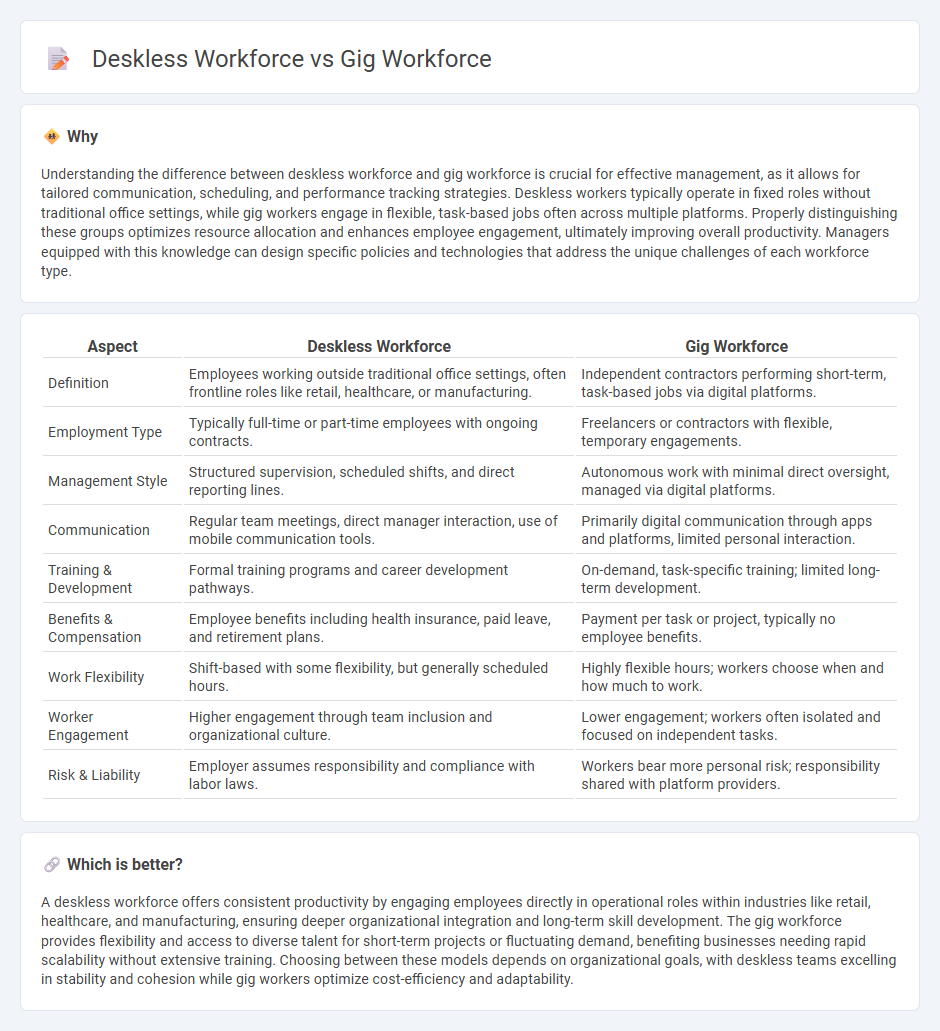
Management strategies for the deskless workforce focus on optimizing real-time communication and task coordination for employees working outside traditional office settings. In contrast, gig workforce management emphasizes flexible scheduling, performance tracking, and ensuring compliance with platform-specific policies for independent contractors. Explore more about tailored management approaches to effectively engage both deskless and gig workers.
Why it is important
Understanding the difference between deskless workforce and gig workforce is crucial for effective management, as it allows for tailored communication, scheduling, and performance tracking strategies. Deskless workers typically operate in fixed roles without traditional office settings, while gig workers engage in flexible, task-based jobs often across multiple platforms. Properly distinguishing these groups optimizes resource allocation and enhances employee engagement, ultimately improving overall productivity. Managers equipped with this knowledge can design specific policies and technologies that address the unique challenges of each workforce type.
Comparison Table
| Aspect | Deskless Workforce | Gig Workforce |
|---|---|---|
| Definition | Employees working outside traditional office settings, often frontline roles like retail, healthcare, or manufacturing. | Independent contractors performing short-term, task-based jobs via digital platforms. |
| Employment Type | Typically full-time or part-time employees with ongoing contracts. | Freelancers or contractors with flexible, temporary engagements. |
| Management Style | Structured supervision, scheduled shifts, and direct reporting lines. | Autonomous work with minimal direct oversight, managed via digital platforms. |
| Communication | Regular team meetings, direct manager interaction, use of mobile communication tools. | Primarily digital communication through apps and platforms, limited personal interaction. |
| Training & Development | Formal training programs and career development pathways. | On-demand, task-specific training; limited long-term development. |
| Benefits & Compensation | Employee benefits including health insurance, paid leave, and retirement plans. | Payment per task or project, typically no employee benefits. |
| Work Flexibility | Shift-based with some flexibility, but generally scheduled hours. | Highly flexible hours; workers choose when and how much to work. |
| Worker Engagement | Higher engagement through team inclusion and organizational culture. | Lower engagement; workers often isolated and focused on independent tasks. |
| Risk & Liability | Employer assumes responsibility and compliance with labor laws. | Workers bear more personal risk; responsibility shared with platform providers. |
Which is better?
A deskless workforce offers consistent productivity by engaging employees directly in operational roles within industries like retail, healthcare, and manufacturing, ensuring deeper organizational integration and long-term skill development. The gig workforce provides flexibility and access to diverse talent for short-term projects or fluctuating demand, benefiting businesses needing rapid scalability without extensive training. Choosing between these models depends on organizational goals, with deskless teams excelling in stability and cohesion while gig workers optimize cost-efficiency and adaptability.
Connection
The deskless workforce, comprising employees working outside traditional office settings, often overlaps with the gig workforce, characterized by short-term, flexible jobs. Both workforces rely heavily on mobile technology and digital platforms to manage tasks, communicate, and track performance. Effective management strategies focus on real-time coordination, streamlined communication, and adaptive scheduling to optimize productivity and engagement for these non-traditional labor segments.
Key Terms
Flexibility
Gig workforce offers unparalleled flexibility by allowing workers to choose projects and schedules that fit their lifestyles, enhancing work-life balance and job satisfaction. Deskless workforce flexibility focuses on dynamic, location-independent roles often supported by mobile technology, enabling real-time communication and task management without traditional office constraints. Explore more about how flexibility shapes productivity and engagement in both gig and deskless workforces.
Autonomy
The gig workforce thrives on flexibility and autonomy, enabling workers to choose projects and set their schedules without traditional supervision. Deskless workforce autonomy varies widely, often limited by employer protocols and on-site operational requirements, but technological advancements are progressively expanding their decision-making power. Explore deeper insights into how autonomy shapes productivity and satisfaction in both workforce models.
Technology Integration
The gig workforce relies heavily on digital platforms and mobile apps to enable flexible task management, real-time communication, and seamless payment processing. The deskless workforce leverages advanced wearable devices, IoT tools, and cloud-based solutions to enhance productivity and streamline on-site operations. Explore how cutting-edge technology integration transforms both workforce models for greater efficiency and innovation.
Source and External Links
Illuminating the Shadow Workforce - This report provides insights into the gig workforce, highlighting its growth across industries and the challenges companies face in managing these workers.
Gig Worker - Gig workers are defined as those engaged in work outside traditional employer-employee arrangements, including independent contractors and platform workers.
Gig Economy Statistics for 2024 - This article provides statistics on the gig economy, including its size, growth projections, and the benefits and challenges it presents for workers and companies.
 dowidth.com
dowidth.com